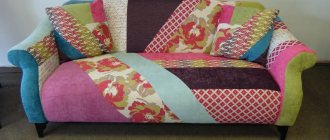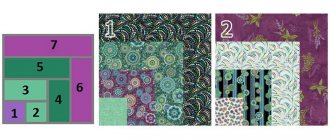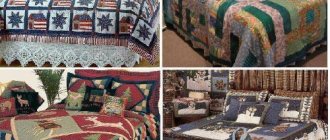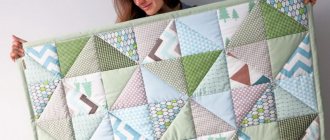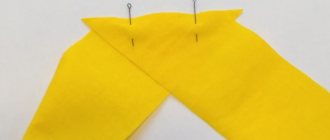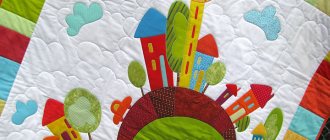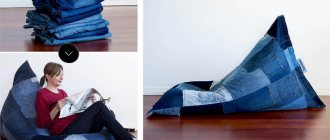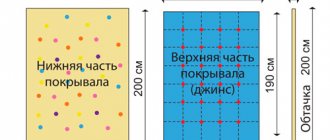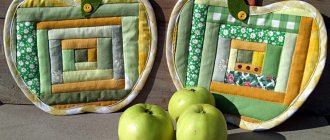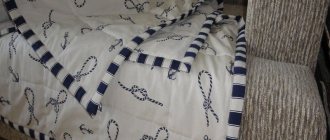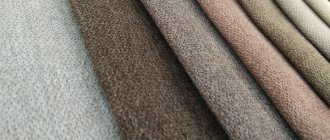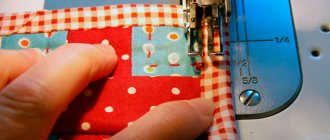Required Tools
To create a product from worn jeans, you need to arm yourself with the materials and tools necessary for this work.
- Unnecessary jeans, preferably several pairs. First of all, you need to prepare the raw materials: carefully select pieces of fabric suitable for sewing; areas with yellowness or discoloration should not be used for work.
- Choose fabric for lining. The lower part of the bedspread should be durable, soft, and warm. For this purpose, it is advisable to choose fabric made from natural fibers; it is best to use wool, satin, and linen. To save money, you can use padding polyester or batting instead of wool. Then, as a lining material, you can take any thin cotton fabric of a suitable color or plain color.
- Select fabric to trim the border around the entire perimeter of the bedspread.
- Threads and sewing needles should be thick and strong. Sewing denim is not easy because of its thickness. It is better to take threads in color to match the main fabric or contrasting ones in order to visually highlight the stitched parts and elements.
- Thick cardboard for making a stencil pattern, a measuring tape, a pencil, a thin piece of dried soap or chalk for marking parts on pieces of fabric.
- Tailor's needles for chopping off parts before stitching, sharp tailor's scissors, a special knife for ripping seams, or small scissors for manicure.
- Sewing machine. Special foot for sewing thick, coarse fabric.
Recommendations from experienced professionals
Beginners will always find some recommendations from experienced craftswomen useful:
- It is advisable to carefully tear off the back pockets of all pairs of old jeans, because they can also be useful for decorating the finished product;
- It is not necessary to wash and iron the entire old jeans; you can first cut out fragments from them and carry out these manipulations with them;
- Don’t be afraid to combine denim of different shades in one blanket;
- you need to purchase only strong, thick needles for sewing denim;
- Jeans that are too old can fall apart during work, so it is advisable to sew them together in large fragments.
Pockets should be carefully opened
Technicians
Today there are a huge number of ways to create patchwork quilts and more:
From the stripes
Perhaps the most common and simple option is the technique of stitching long strips of equal width. This blanket will resemble a cobblestone fence, especially if you choose the color.
Well
One of the ancient techniques for creating a unique pattern is the American square or well. This style of tailoring was very popular two centuries ago in America and, accordingly, in Europe. The basis of this ornament is a square, which is sewn together from stripes that gradually increase in length. This creates the illusion of a log well when viewed from top to bottom.
There are several options for creating such a drawing.
At its base and beginning there is a square, which is sheathed on each side with a strip of fabric, and each subsequent “log” is sewn overlapping each other in a circle. The stripes can increase in width or remain the same, the main thing is to change the shades of the tiers to create the effect of a three-dimensional well. You can also make a dark middle and sew lighter patches closer to the edge.
From squares
One of the oldest and simplest ways to create a quilt is to sew squares together. They can be large, medium in size, or reach up to 1-4 cm in area. The main visibility of the pattern is created by the color and sequence of stitching of the flaps. The ornament can have 2 colors and resemble a chessboard, but the option with a wide variety of color palette looks more interesting. Some artists can create portraits from rectangular cuts, reminiscent of a pixel photograph.
Any geometric figure, for example a triangle, can be taken as the basis for the stitched pattern. It is very easy to work with, since you can make a rectangle, the same square, and even a circle or rhombus from it.
The most common ornaments made from this figure are “mill”, “star”, “flower”.
Watercolor
Watercolor technique is very creative. The product can be made from scraps of different shapes (squares, rectangles, etc.), but the most important thing is the color. The cuts are selected in such a way that the tones are approximately in the same color range. In its stitched, finished form, this canvas resembles a canvas on which it was painted with watercolor paint. Such blankets look very soft and airy.
From hexagons
The “honeycomb” technique is very close to nature. To do this, hexagons are cut out and sewn together, and most often, the entire blanket is made of beige or light rags, and only some hexagons are made of honey or yellow color, so as not to look too tacky. You can sew small bees on top to make the product more atmospheric. But such a figure is not always used to imitate a honeycomb; very often the hexagons can be multi-colored and lay out a whole, bright product.
"Lyapochika"
One of the most beautiful and voluminous patchwork techniques is called “Lyapochika”. If you have accumulated a very impressive amount of old and unnecessary knitted T-shirts or T-shirts, then you can make an amazing patchwork quilt out of them. First you need to buy the fabric on which everything will be sewn. Then the items are cut into pieces (preferably rectangular) and, without finishing the edges, they are sewn layer by layer onto the base.
If you sort the cut pieces of fabric by color, you can lay out a design or pattern. Most often they make flowers or imitation sheep wool or fish scales.
All other techniques for creating ornaments are based on the above. Weaving and stitching the flaps alternate, resulting in a colorful and original design.
An interesting solution would be to make a plaid or blanket crocheted in a patchwork style. Thus, you can knit a very beautiful pattern using many colors. Typically, threads made of wool, acrylic, or a mixture of both are used. But the most interesting thing is that you can use thinly sliced and fastened fabric scraps as a thread. For this type of knitting you will have to use a larger hook.
Features, pros and cons
Patchwork style pillows or more simply “patchwork” pillows are decorative accessories made from scraps of different shapes and sizes, scraps of different fabrics. This is painstaking work to create a product with a specific pattern of varying degrees of complexity. The technique is ancient, its appearance was associated with a shortage of textiles, so every piece of work had value.
Over time, the chaotic selection of scraps was replaced by the correct layout, taking into account the color scheme and a specific theme
Today, special attention is paid to needlework, so in stores you can purchase not only ready-made sets in the same style, but also “correct” blanks, be it individual square elements or ready-made sets with cut fragments
Pillows made from patches have many advantages:
- can dictate a design idea or support a specific piece of furniture;
- are self-sufficient accents or are included in a set with a bedspread, rug, blanket, or covers for upholstered furniture;
- are made on a sewing machine, therefore they are tear-resistant and durable;
- can be located anywhere in the room, decorating the surface of furniture (sofa, armchairs, chairs, stools) or window sills;
- have a wide range of sizes and variations in shape;
- are distinguished by a variety of carved fragments and a rich selection of color palettes;
- look professional and bright, obeying the rules for selecting the texture of the material;
- made from textiles of natural and synthetic origin;
- are divided into several drawing techniques, assembled according to a pre-prepared scheme;
- are made in the form of full-fledged pillows or as decorative pillowcases to fit the size of existing pillowcases, taking into account ease of care (they can have a zipper or buttons with loops);
- can combine different handicraft techniques (for example, classics and Japanese “patchwork” kinusaiga, iris folding, etc.);
- are a favorite topic of needlework for experienced craftswomen and inspire the creativity of beginners;
- recognized as an excellent gift for yourself or loved ones for a celebration;
- easy to care for, machine washable at 40 degrees, easy to spin and dry naturally;
- depending on the pattern and color scheme, they can create a visual illusion of increasing the space of the room;
- create a feeling of home comfort by maintaining a comfortable atmosphere or zoning a certain part of the room.
Patchwork pillows can be functional household items (for example, transformable models in the form of covers for bedding, pajamas). According to the production method, they can be single-sided with a pattern on one side, double-sided, decorated with the same or different patterns on both sides.
With a lot of advantages, patchwork sofa cushions have several nuances:
- require a large amount of free time to produce a high-quality product;
- look professional only with patience, precision and accuracy (errors in the assembly of each element are unacceptable);
- they look beautiful with a pattern, but without it they create a feeling of variegated and overloaded design;
- due to creation from separate fragments, they require a mandatory gasket covering the surface of the connected parts from the wrong side;
- “marketable” look made from new materials purchased specifically for needlework.
The cost of such things usually cannot be called budget. As a rule, professional craftswomen have their own tariff, which is based on an hourly rate, so buying a set of several pillows and, say, a blanket can be expensive. However, in most cases this is not an obstacle to purchasing, since there are many connoisseurs of such art, and they are ready to do anything to decorate their interior with exclusive new items.
How to make patchwork pillows with your own hands
Having decided to make such a decorative element with your own hands, you should determine which technique is best suited for creating a pillow. There is a master class that helps beginners learn how to create different models.
First, you need to choose your own scheme; with its help, no matter what technique you choose, you will be able to correctly complete the job you started. Moreover, the shreds can differ in size and color, and can also be made from different types of fabric.
Even a beginner can master patchwork, because in this matter what is more important is not sleight of hand, but a creative mindset
Therefore, if you decide to decorate sofa cushions with your own hands, you can use fabric scraps in any way you like, thereby creating your own unique patchwork style. After all, there is no clearly established type of pillow, and before you start sewing, you should determine which shape (round, square or rectangular) and size will best suit the interior.
Thanks to the use of a special pattern, even a beginner can quickly sew a patchwork pillow, and this activity will become an interesting and favorite hobby.
How to care for a denim blanket?
Making a blanket from pieces of fabric is quite labor-intensive work, so it would be a shame for any craftswoman to damage the product as a result of improper care. So, if it is used as a blanket for a sofa, it will require monthly washing and cleaning of dirt as needed. It is worth noting that a product made of denim is suitable for pet lovers, because you can quickly remove hair from it, and it is not so easy to tear it with claws or teeth.
It is important to adhere to the following care recommendations:
- small traces of dirt can be wiped off using a regular dishwashing sponge, after wetting it;
- The product must be washed every month using regular powder;
- products that combine denim with delicate fabrics can only be washed by hand with a mild detergent;
- You can dry the blanket after washing by hanging it on the dryer or in a horizontal position. Some types of denim can only be washed in a washing machine on a delicate cycle.
In order to make a blanket from pieces of denim with your own hands, you do not need to have any experience working with similar products. There are a large number of fairly simple schemes that anyone can handle. Of course, it is important to know how to use a sewing machine - after all, all the lines must turn out perfectly even. Accuracy, patience and a little imagination, and then the blanket will turn out beautiful and you will use it with pleasure!
How to sew a beautiful blanket from jeans with your own hands: design options
Strictly speaking, everything that is sewn from scraps is patchwork. However, if a bedspread consisting of simple denim squares can be called patchwork, then it is a stretch. More complex forms are closer to this technique; the comparison can be seen in the photo.
Jeans can be combined with each other in shades and textures. It also goes well with any other fabrics, except, perhaps, satin and organza. Other fabrics only benefit from being combined with jeans.
In addition to squares, other geometric shapes are also used - mainly rectangles. They are placed differently on the base, resulting in separate geometric shapes within shapes - zigzags, squares, and so on.
Another delightful option for needlewomen is a combination of rectangles, squares, triangles, circles - and the result is something incredibly chic!
Those who think that only basic material can be used are sorely mistaken. Plaids and bedspreads made from seams, pockets and belts are no less common than those made from squares. Of course, sewing seams together with a zigzag is painstaking and tedious work, but the results are worth it. It is technically difficult to sew pockets - thick material is difficult to handle with a simple sewing machine. In addition, the pockets themselves need to be sewn up, also using a machine. But such bedspreads look very original.
Of course, it all depends on the size of the bedspread you want to get as a result. But if we talk about a simple bedspread made of squares for a one-and-a-half bed, the approximate number of fragments is about two hundred. With a final square size of 10 by 10 cm, the optimal size is considered to be from 10 to 20 cm for a square, and from 15 to 25 cm for a circle.
Of course, it is impossible to indicate the exact number of denim items that will be used to sew a bedspread - first of all, because items of different sizes naturally result in a different number of fragments.
In addition to the denim scraps, you will also need a base fabric, otherwise, in addition to a stylish bedspread, you will get an inexhaustible source of thread in the house as a bonus. Another option is a double-sided blanket, but it will cost exactly twice as much to cover the jeans.
The master class on sewing a simple denim bedspread is quite monotonous and completely uncomplicated. You perform the main actions at the very beginning. So, to work you will need:
- A certain number of jeans
- Felt pen or fabric chalk
- Scissors, tailor's pins
- Sewing machine
- Fabric base
- Dense and thick cardboard
Operating procedure. First stage. Cut a square measuring 12 by 12 cm from thick cardboard. This is the main template. Next, you need to use this template to cut out the maximum possible number of squares from the jeans. It’s rare that you can gather material for a whole blanket at one time - if you sew from old things. In fabric stores, denim is sold in rolls - buy it - I don’t want it.
However, you need to determine how many squares will go on one row of the bedspread. Considering that after stitching, the size of the square will be 10 by 10 cm, measure the width and length required for the bedspread. If you decide to decorate an old blanket, even better, you have the required dimensions; you just need to divide the numbers by 10.
When all the squares are ready, lay them out on the floor and arrange them by color or texture. With a large amount of material you can get a real work of art.
When all the details are in the order that suits you, collect them in order and number them - this way the sequence of colors will not be lost.
Second phase. It is better to sew according to the width of the blanket. Fold the blanks in pairs with their right sides facing each other, and sew a line, retreating a centimeter from the edge.
Determine the number of squares in a row yourself; after stitching one strip, you can attach it to the base or the bed itself to determine the optimal length of the strip. After all the rows in width are ready, they can be sewn along the length. It is better to fasten the threads on each row at once - otherwise, later, tying all the knots, you can go crazy.
Third stage. Fold the finished blanket of squares with the base, back to back. Secure with pins. And then sew each row along with the base. You can sew braid or bias tape around the perimeter. Another option is to fold the edges of the denim side inward along with the folded edge of the base, but this method is inconvenient and the thickness of the edges will stand out.
The blanket is ready!
Uncover
You can sew a blanket from denim scraps using a variety of cutting patterns. The result will be a product of different parameters, design and shape. To quickly progress the work, you will need to prepare preparations in advance. Their number and type directly depend on the style of the bedspread.
You can cut in squares, hexagons, stripes
Bedspread cutting samples can be of the following options:
- square and fringed using patchwork technique, from 350 elements with parameters 15x15 cm;
- from 252 square fragments with parameters 12x12 cm;
- from square elements 12x12 cm and 120 strips 2.5x12, 2.5x14.5, 2x14.5, 2x16.5 cm.
- from areas with motifs, using 20x20 cm squares of 2 color shades.
You can come up with a model yourself or use ready-made ideas. This type of needlework refers to a creative handmade technique. Canvases with a mosaic layout of denim patches with fluffy fringe look impressive.
What are patchwork pillowcases
Today, the most common product among patchwork designs are patchwork pillows. And needlewomen give particular preference to sewing decorative pillowcases.
Before you start sewing, you should apply the finished patchwork design to the fabric. After this, the pillowcase pattern must be transferred to the canvas, folded right side inward. Be sure to leave allowances for fastening.
In order for the pillowcase to fit perfectly into the interior, it is important to choose the right style in which it should be made. It won't be a problem with so many great ideas out there and it won't take much time.
Before you start sewing a pillowcase in patchwork style, you need to apply the finished patchwork pattern to the fabric
By starting to create such pillowcases, even a beginner can quickly learn patchwork sewing and, over time, acquire good skills in the production of other patchwork products.
What are jeans paintings for?
The purpose of denim creativity can be very diverse. This is not only a good way to spend time doing something creative, but also an opportunity to learn something new and develop your skills. Handicrafts have always been considered an excellent way to develop and spend time.
The resulting activity result can be:
- Interior decoration;
- The basis for bags, rugs, clothes and other useful things;
- Work for exhibitions, competitions.
Creating something new and unusual is always interesting. What’s especially pleasing is the opportunity to get results without much investment.
For creativity you will need a minimum of supplies, which can always be found among scrap materials. Even if nothing works out, there will be no regrets about the money spent.
Stages of work
Selection of material
You can take new or used materials. The main thing is that they are clean and washed (even new fabric needs to be washed to shrink). If the fabric scraps are not new, it makes sense to starch them a little and iron them.
Experts recommend not to forget about the following selection rules.
- The easiest to work with are cotton fabrics: they hold their shape perfectly and are as convenient as possible in cutting and sewing. Finally, they are natural and relatively inexpensive. Napkins, potholders, lunch mats, tea warmers, various capes, pillows and blankets are beautifully made of cotton.
- Gabardine, tweed and even drape can also be used in patchwork mosaics. They are used to make panels, thick blankets and rugs.
- Silk scraps can also be used, but silk fragments wear out quickly. Therefore, silk can be used to model patchwork paintings, but it should not be used for pillows and blankets, which are used practically.
- Knitwear is rarely used for patchwork because it is difficult to sew from. But things made of leather (including artificial leather) are made regularly.
Fabrics can be combined, but this does not always work out successfully. On sale today you can find creativity kits that already come with pieces of fabric that fit perfectly together.
Scheme selection
The diagram is an instruction that will allow you not to get lost in the colored patches and do everything technologically correctly. Today you don’t have to draw diagrams yourself: just find an interesting option on the Internet, print it out and cut it into parts. More experienced craftsmen make the templates themselves because they can intuitively understand what a new model from scraps will look like.
Little tips:
- there is no need to throw away templates, even if it seems that you are unlikely to want to repeat a specific product or everything is already clear and your memory will not let you down;
- It’s convenient to use folders with files to store diagrams, since diagrams get wrinkled, lost, and confused in boxes;
- on the details of the diagram you can make notes regarding the choice of fabric: when the product is ready, it becomes clear whether the colors and materials are arranged appropriately;
- The templates are cut using scissors along the dotted lines: not all templates leave a seam allowance, this must be taken into account;
- You can independently draw up a diagram on whatman paper: indicate on the drawing an ornament or design, the required number of parts, possible colors of fabrics.
Sewing is a technological process. Only very talented people with an excellent eye and an enviable sense of composition can do without diagrams and patterns. Don’t overestimate your own capabilities: it’s better to tinker a little longer, but the result will be impeccable.
Determining how to connect the patches
The most actively used are 2 patchwork sewing techniques: American and block. In the first case, identical figures are basted to each other using paper templates. Then a seam allowance is made for the turn-up, and then the piece is basted again. Block tactics are more often used in modern master classes. Triangular or square elements are connected into blocks. Then they are sewn to the base, resulting in a beautiful three-dimensional pattern.
If we are talking about crazy patchwork, the seams are treated fundamentally differently: they must be decorated. This can be to disguise the seam with elegant braid, lace, ribbons, or beads. The artistic stitch (“curly”) is popular, as are unusual options that imitate bird tracks, a Christmas tree, falling snowflakes, etc. Buttons, beads, beads, and rhinestones can be woven and sewn into artistic stitches.
What will you have to work with?
The main material for making a picture from jeans is the appropriate fabric. More often they prefer to work with what they can find in their own bins. This is not new material, but old denim items, various scraps of fabric.
Additionally, you can use various products for creativity: beads, rhinestones, ribbons. I managed to create denim paintings using different techniques.
Therefore, tools and materials for creativity may be different. These include:
- Needles, threads for sewing;
- Glue;
- All kinds of stationery.
You can create works only with your own hands or using technical means. To begin with, they decide on the work technique and come up with an idea. After this, it becomes clear what needs to be prepared and how to act.
The best ideas in the interior
Of course, a patchwork quilt is one of the decorative elements in the room, so you should be careful when sewing it, choosing the optimal colors and materials. For small rooms, patchwork blankets made in light, light colors are suitable, so the sleeping area will not seem large, but, on the contrary, very compact
An excellent addition to the interior will be the same pillows and chair covers, if they are in the room. Often made from scraps of bean bag chairs, they look very interesting in the room, and also delight with their practicality and softness
For small rooms, patchwork blankets made in light, light colors are suitable, so the sleeping area will not seem large, but, on the contrary, very compact. An excellent addition to the interior will be the same pillows and chair covers, if they are in the room. Often made from scraps of bean bag chairs, they look very interesting in the room, and also delight with their practicality and softness.
If you decided to make a bedspread from scraps for the living room, then you need to proceed from the general atmosphere. For example, a room is decorated in Provence style and has enough free space, then you can create a voluminous bedspread in turquoise and pink tones, as well as make the same pillows that can be laid out on separate armchairs, creating a complete picture. The blanket can also be made using watercolor or checkerboard techniques.
As can be seen from the interior of this bright room, a knitted patchwork bedspread perfectly complements the space, and it does not distract unnecessary attention to itself at all, leaving the room very calm and harmonious.
Despite the large abundance of colors in the patchwork quilt, they blend very harmoniously with the overall decor. The room is conducive to complete relaxation and wonderful sleep.
This example shows that the sleeping area is overcrowded with bright and catchy colors, so it will be difficult to calm down and fall asleep here.
There's an incredible sense of style on display here. The blanket is sewn in such a way that it matches the entire furnishings in the room, and there are also curtains made in the same style. Despite the fact that there are a lot of patchwork items in the room, it does not seem pretentious. This is achieved due to the color and texture of the fabric itself.
To learn how to sew a “Random Color” quilt in 30 minutes, watch the following video
